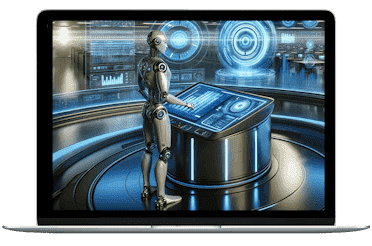Is a Chatbot Suitable for Your Small Business?
In today's digital age, where convenience and efficiency are paramount, small businesses are constantly seeking ways to streamline their operations while enhancing customer experiences. One innovative solution that has gained considerable traction is the chatbot. But the question remains: Is a chatbot right for your small business?
What is a Chatbot?
A chatbot is an artificial intelligence (AI) software designed to simulate human conversation, either through text or voice interactions. These automated agents are programmed to understand and respond to user inquiries, perform tasks, and even initiate conversations without human intervention.
Importance of Chatbots for Small Businesses
Small businesses often face resource constraints, making it challenging to provide round-the-clock customer support or handle large volumes of inquiries efficiently. Chatbots offer a cost-effective solution by automating repetitive tasks, allowing businesses to focus their resources on strategic initiatives.


Benefits of Chatbots for Small Businesses
24/7 Availability
Unlike human agents, chatbots are available 24/7, ensuring that customers receive assistance whenever they need it. This round-the-clock availability improves customer satisfaction and reduces response times.
Cost-Effective Customer Support
Implementing a chatbot can significantly reduce the cost of customer support. By handling routine inquiries and tasks, chatbots free up human agents to address more complex issues, thereby optimizing resource allocation.
Improved Customer Engagement
Chatbots can engage customers in interactive conversations, providing personalized recommendations, answering product-related queries, and even facilitating transactions. This personalized approach enhances customer engagement and fosters brand loyalty.
Data Collection and Analysis
Chatbots can collect valuable data from customer interactions, such as preferences, behavior patterns, and frequently asked questions. This data can be analyzed to gain insights into customer needs and preferences, enabling businesses to tailor their offerings and marketing strategies accordingly.


Types of Chatbots
Rule-Based Chatbots
Rule-based chatbots operate on predefined rules and decision trees. They follow a set of instructions to respond to user queries based on keywords or phrases, making them suitable for simple and structured conversations.
AI-Powered Chatbots
AI-powered chatbots leverage machine learning algorithms to understand natural language and context, allowing them to engage in more complex and dynamic conversations. These chatbots learn from interactions over time, continuously improving their accuracy and effectiveness.
Considerations Before Implementing a Chatbot
Define Objectives
Before implementing a chatbot, it's essential to define clear objectives and goals. Whether it's improving customer service, increasing sales, or enhancing operational efficiency, aligning the chatbot's capabilities with your business objectives is crucial for success.
Know Your Audience
Understanding your target audience's preferences, communication preferences, and pain points is essential for designing a chatbot that resonates with them. Conducting market research and gathering customer feedback can provide valuable insights into customer needs and expectations.
Choose the Right Platform
Selecting the right chatbot platform is critical for ensuring seamless integration with your existing systems and workflows. Whether it's a standalone chatbot solution or an integrated platform with CRM and e-commerce capabilities, choose a platform that meets your business requirements.
Test and Iterate
Testing is an integral part of the chatbot implementation process. Conducting thorough testing ensures that the chatbot functions as intended, delivers accurate responses, and provides a seamless user experience. Additionally, gather feedback from users and iterate on the chatbot's design and functionality based on their input.
Common Misconceptions About Chatbots
Chatbots are Expensive
Contrary to popular belief, implementing a chatbot doesn't have to be expensive. With advancements in AI technology and the availability of affordable chatbot platforms, small businesses can leverage chatbots to enhance customer experiences without breaking the bank.
Chatbots are Only for Large Businesses
While chatbots have traditionally been associated with large corporations, small businesses can also benefit from their implementation. In fact, chatbots offer small businesses a competitive advantage by enabling them to provide personalized and responsive customer support on a limited budget.
Chatbots Replace Human Interaction Completely
While chatbots can handle routine inquiries and tasks, they are not meant to replace human interaction entirely. Human agents still play a crucial role in addressing complex issues, providing empathetic support, and building meaningful relationships with customers. Chatbots complement human agents by handling repetitive tasks, freeing them up to focus on higher-value activities.


Case Studies: Successful Implementation of Chatbots
Small Business A: Customer Service Enhancement
A small e-commerce retailer implemented a chatbot to assist customers with product inquiries, order tracking, and returns. The chatbot's 24/7 availability and quick response times resulted in increased customer satisfaction and reduced support costs.
Small Business B: Lead Generation Boost
A local service provider integrated a chatbot into their website to capture leads and schedule appointments. The chatbot engaged visitors in personalized conversations, qualifying leads and guiding them through the booking process, resulting in a significant increase in conversions.
Steps to Implement a Chatbot for Your Small Business
Choose a Chatbot Platform
Research and select a chatbot platform that aligns with your business needs and budget. Consider factors such as functionality, integration capabilities, pricing, and customer support.
Design Conversation Flows
Map out the conversation flows and user journeys to ensure a seamless and intuitive chatbot experience. Define the types of inquiries the chatbot will handle and craft responses that align with your brand voice and messaging.
Integrate with Existing Systems
Integrate the chatbot with your existing systems, such as CRM software, e-commerce platforms, and messaging channels, to ensure smooth communication and data synchronization.
Train and Test
Train the chatbot using sample conversations and test its functionality across different scenarios and user inputs. Continuously monitor and refine the chatbot based on user feedback



